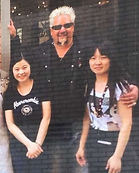Chongqing chicken
- jbucks00
- Nov 17, 2018
- 4 min read
Americans obsession over Chinese food is so puzzling. A country of 1.38 billion people, 23 separate provinces, and yet the fetishization of unholy Cantonese cuisine featuring the all too familiar corn starch ridden sauces and untraditional complimentary, always stale, fortune cookies with underwhelming innuendos continues. Americanized Cantonese cuisine has gone too far, and I'm over it. I never want to see a maraschino cherry outside the comforts of an alcohol beverage. Canned pineapple deserves ostracization indefinitely, not just from my chicken and rice but from this earth. I do think we're at a crossroads with acceptance of traditional ethnic cuisine and I'm more than okay with that.
I found myself again at Chong Qing House ready to face any form of Chinese exchange student mockery due to my chopstick incompetence. Why you say, face excruciating public humiliation for the second time in less than a week? Well, I'm not sure. The mouth-numbing Szechuan peppers, poorly cut Chinese leeks, complimentary black tea, possible even Flo Rida vocal tones quaintly escaping from the depths of the kitchen were all worth foreseeable mockery for a second time. But as I sat down at four in the afternoon, I found myself the sole Chong Qing House recipient. It was undeniably lonely. Pulling out to read this week's Economist featuring such gleeful stories like Bangladesh's grotesque politics didn't provide any form of aid to my isolation. If the group of ten Asian Macklemore's that once laughed at my demise arrived together as a single party, as much as this hurts to admit, I would be happy. Curing my gloom could only be completed in one way and one way only, ordering Sichuanese food. So I did precisely that.
Authentic Sichuanese food when referred to as "mala" literally translates to numbing and spice. Most Sichuanese dishes are inclusive of Sichuan pepper or huajiao which provide this sense of numbness in the mouth. The usual accompaniments of garlic, ginger, star anise follow, maybe some broad bean chili paste if we're getting fancy. These all necessary components for proper dish enhancement.
After looking at poorly taken Yelp photos from users like JeffDan432, it became apparent the right thing to do was to ignore all of my financial holds and purchase the $18 dish of Chongqing chicken with dried chilis. Enhanced with wilting cilantro, a bowl of properly cooked white rice, and my complimentary black tea, it was singularly the best dish I've eaten in months. Concerning flavor, it was as if McDonald's nuggets happened to be made of actual chicken, then tossed with citrus-like, intensely flavored chilis. Notes of garlic and Chinese woven harmoniously into the mixture furthered my enjoyment.
Obviously, in our sorry state of Connecticut, finding a proper Sichuanese restaurant is as hard as finding someone not wearing any form of Vineyard Vines apparel in Greenwich. So I went on the internet and found a recipe in which anyone that happens to actually read this far into the article will never make.
1 pound skinless dark-meat chicken
1 tablespoon Shaoxing wine
1 tablespoon Chinese light soy sauce
4 tablespoons potato starch or corn starch
1 tablespoon Sichuan chili flakes or powder1 tablespoon freshly ground, roasted Sichuan pepper1
heaping teaspoon kosher salt1½ cups peanut or canola oil
5 garlic cloves, thinly sliced
1 tablespoon thinly sliced ginger
2 tablespoons Sichuan ground chilies
1 tablespoon sesame seeds
At least 3 cups/3 ounces whole dried red Sichuan chilies (snip some in half and include seeds for a spicier version)
2 teaspoons red Sichuan peppercorns (or 1 teaspoon red and 1 teaspoon green Sichuan peppercorns)
1 teaspoon sugar
4 scallions, roughly chopped, whites and greens separated
Marinate chicken pieces in Shaoxing wine and soy sauce while you prepare the other ingredients.Mix corn starch, cayenne chili powder, ground Sichuan pepper and salt in a large sealable baggie. Add the chicken pieces, leaving any accumulated juices behind. Shake the chicken pieces in the potato starch mixture until they are lightly coated.Heat wok on high heat until wisps of smoke start to rise and add enough canola or vegetable oil to deep-fry the chicken, about 1½ cups. If your wok or pan is large enough, you can fry it in one batch, but do not overcrowd the chicken. When oil is hot, add the chicken pieces and reduce heat to medium; the frying process should produce a medium bubble, frying at around 350°. When the chicken pieces appear to be cooked through, remove them from the oil to rest on paper towels. Return the oil to a high heat and add back the chicken in two batches, so they are not at all crowded. This time they should finish frying at a high heat, about 375°F, with a large, fast bubble. Fry just until the chicken is crispy and golden brown, then remove to drain on paper towels.Pour off oil to a bowl, clean the wok and return to heat. When hot, add back 4 tablespoons of the frying oil. Heat briefly on medium heat, then add the garlic and ginger and cook until softened. Stir-fry vigorously from now on, as you don't want anything to brown. Add the chili flakes and sesame seeds, stirring until lightly toasted, then add the whole chili peppers, Sichuan peppercorns and scallion whites. Stir until fragrant, then add the sugar.Add back the chicken along with the scallion greens, and stir-fry until well mixed. Plate with chili peppers prominently displayed.
Again, I just stole this recipe off of the internet so I have no idea of whether or no it's actually valid.







.jpg)



.jpg)

.jpg)





.jpg)









Comments